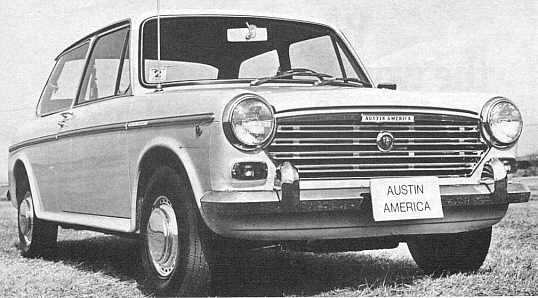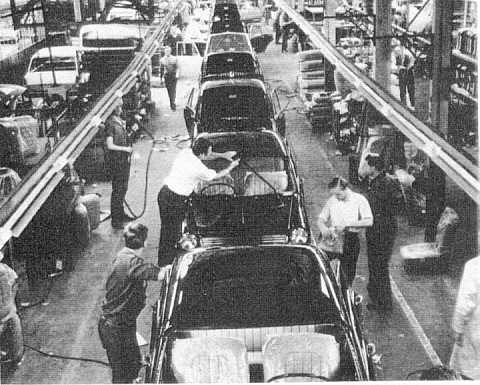|

The Austin America:
The Austin America was a special version of the two-door Austin 1300. Approximately 59,500 of them were made exclusively for
export to the U.S.A. and were sold from 1968 to 1972. The Americas were intended to compete directly with the highly successful
VW Beetle and throughout the sales, the marketing campaign advertised them as, "The perfect second car." One ad
compared the road holding stability of the two by showing an image of the Beetle as a kite and the America as a brick.
The Austin America was available with either a 4 speed all synchromesh, manual transmission or with a 4
speed automatic transmission. The automatic transmission could be shifted manually, or left in "Drive" to shift
on its own.
Year model variations:
There were only subtle differences between the different year models:
1968-1969
1968/69 models were positive ground, had a generator, no side marker lights, and wide stainless steel
body side mouldings. The overriders on the bumpers were just chrome, with no rubber centers. A psuedo winged emblem with the
Austin Coat-of-Arms was located in each front fender to cover the openings that would later be used for sidemarker lights
in the 1970 models. Inside they had a 2 spoke steering wheel with a fake woodgrained grip area and headrests that were
so tall they had to be folded forward in order to lift the seats so rear passengers could get in and out. The ignition
switch was mounted in the center of the dash in between the generator and oil pressure warning lights.
1970
1970 models were negative ground, had short rectangular sidemarker lights on the front and rear fenders, and wide stainless
body side mouldings. The bumper over-riders had wide rubber pads in the faces. The headrests were short and rounded, like
the MG Midgets and MGB's. The steering wheel was 3 spoke sport model with a wide black rubber grip area. Later 1970 cars had
an alternator with internal voltage regulator, and the ignition switch was mounted to the steering column instead of in the
dash. This allowed for the steering to be locked when the key was removed.
1971
1971 was the same as late 1970, but had thin body side trim and long rectangular sidemarker lights. They had dash faces that
were covered with a fake woodgrain look. The grill was changed to the more open looking "1300 GT" grill. The trunk
badge was changed to a mod 70's looking script that was all chrome and said "America." The rear license plate light
was moved from the bumper up onto the trunk. It was mounted under a wide plastic housing that stuck out from the trunk lid
and had a dual role as an opening handle. The tail lights were two-tone and had amber upper turnsignal areas. The front parking/turnsignal
lenses were two-tone with a clear lens over the parking light and an amber lens over the turnsignal. The front seats were
mounted on sliding tracks and the seat backs folded forward to make it easier for passengers to get in and out of the back
seat. This was also the first year that the interior upholstery was available in colors other than black. The decorative tin
trim rings were not used on the wheels of this year model.
All models had a single HS4 (1-1/2") SU carburetor and a smog pump to meet emmission standards. From
1970 onward, the California cars (and possibly those sold in other states) also had a charcoal canister vapor recovery system.
This was designed to store fuel tank and engine crankcase vapors while the car was parked. These vapors were later burned
by the running engine. The California cars also had a larger fuel filler neck which used a larger gas cap. Also from
1970, the carburetors started using the swinging needle instead of the earlier fixed needle design.
A sad reputation:
Unfortunately, most of the cars were plagued with numerous mechanical problems and in damp climates, severe rust. In the
U.S.A., they suffered from being underpowered and not able to withstand the fast freeway driving to which the American consumer
was accustomed. Since the automatic transmission version was heavily advertised and sold, it subsequently failed most often.
Like the manual transmission, the automatic, also being the oil pan, ran in the engine oil. This made it extremely succeptable
to failure and many of the automatics were in for transmission repairs while still under warranty.
Since the
engine and transmission shared the same oil, and sat one on top of the other, when one failed, it often caused problems and
damage to the other. The cars gained a reputation for being unreliable and they soon paled in comparison to the VW's, Hondas,
Datsuns and Toyotas of the time. With an original sales price of between $1,900.00 to $2,200.00, it was probably difficult
to justify the expense of rebuilding an engine or transmission after a serious failure, when the car was only a few years
old. A testiment to this is the number of Americas that used to be in the wrecking yards with less than 50,000 miles on the
odometers.
Fate of a great car:
The final fate of many Americas was as engine donors for the Mini enthusiasts who were looking to replace their smaller engines
with a 1275cc engine. The bodies which didn't share anything in common with their little brother Minis were then scrapped
at the wrecking yard.
Today, very few Americas remain. Of those that are left, even fewer are still on
the road and fewer still are driven regularly. A sad fate for a car that, along with the Mini, is credited with being the
first mass produced front wheel drive passenger car. And, a car that ultimately set a design standard by which "economy"
cars still follow.

More ADO-16 Production History:
Declan Berridge is rapidly becoming one of the foremost historians on the
ADO-16 line. He's created several documents detailing the history and production of the marque. Use the links below to
view an easy to read "Flow Chart" formatted production time-line, and a unique photo album of prototypes. These are
becoming the quintessential historical documents for the history of the marques.
Keith Adams has written two very informative and accurate on-line articles on the
production history of the ADO-16. Excellent information and some fantastic photos of the prototypes and early models.
|



